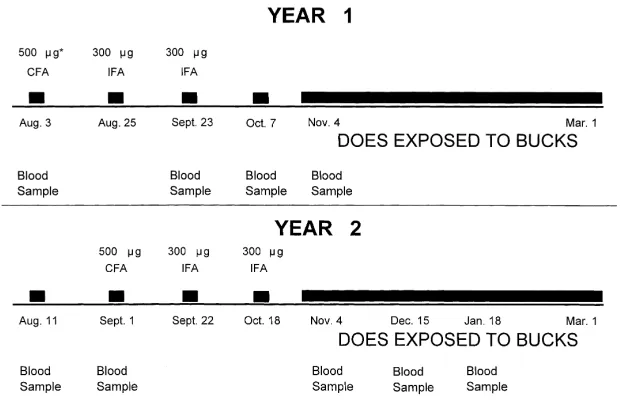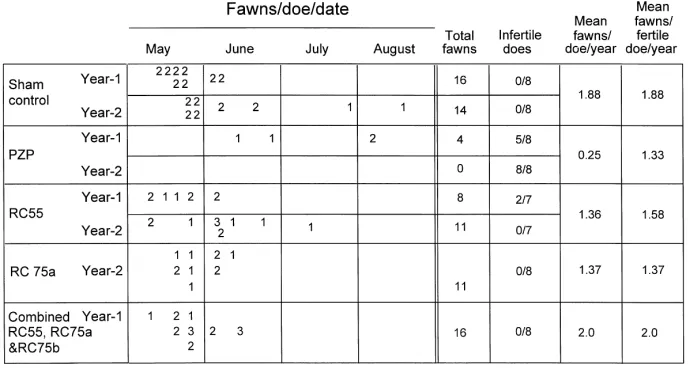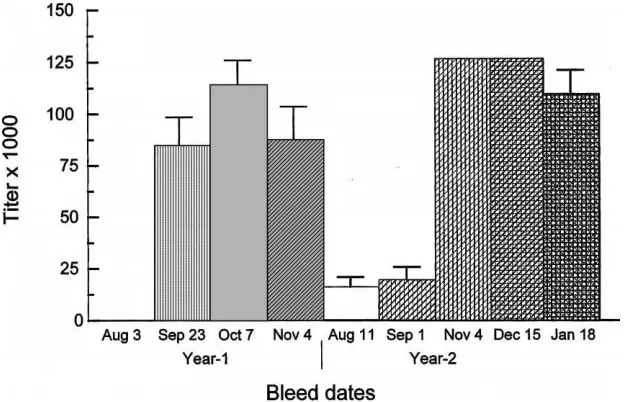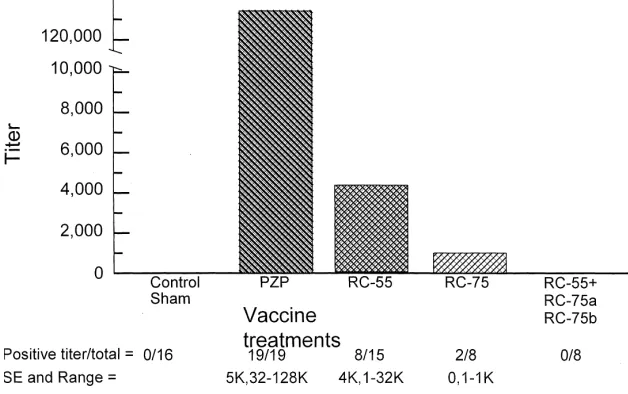Immunocontraception of white-tailed deer using
native and recombinant zona pellucida vaccines
Lowell A. Miller
a,∗, Brad E. Johns
a, Gary J. Killian
b aU.S. Department of Agriculture, National Wildlife Research Center, Fort Collins, CO 80521 USA bDepartment of Dairy and Animal Science, Pennsylvania State University, University Park, PA 16802 USAReceived 28 September 1999; received in revised form 25 April 2000; accepted 5 May 2000
Abstract
We conducted a 2-year feasibility study with native porcine zona pellucida (PZP) vaccine and three recombinant rabbit zona pellucida vaccines (RC55, RC75a and a combination of RC55, RC75a and RC75b) as an initial phase of developing a recombinant immunocontraceptive vaccine to control reproduction in overpopulated herds of white-tailed deer (Odocoileus virginianus). Forty captive white-tailed does were divided into five groups (one sham and four treated), of eight each and injected with a 500mg prime dose of vaccine. Each prime dose was followed by a 300mg booster dose at 3–7 weeks post prime. The frequency and number of months of observed breeding were higher in PZP immunized does than in sham controls. Although the antibody titers of the three recombinant groups were 1000 or less, as compared with the PZP group with titers often over 128,000, the fawning rates of the two recombinants were significantly lower than that of the control group. The combined antigen group did not have a significantly lower fawning rate. © 2000 Elsevier Science B.V. All rights reserved.
Keywords: Fertility control; Odocoileus virginianus; Porcine zona pellucida; PZP; Recombinant peptide
1. Introduction
Native porcine ZP (PZP) vaccines have produced infertility in various mammals including the rabbit, dog, monkey, horse, burro, and baboon (Kirkpatrick et al., 1990, 1996; Garrott et al., 1992; Turner and Kirkpatrick, 1991; Turner et al., 1996b). Investigators have (Turner et al., 1992, 1996a, 1997; McShea et al., 1997; Miller, 1997; Miller et al., 1999) demonstrated that infertility in white-tailed deer can be accomplished by remotely delivered native PZP. Several scientists have shown that antibodies made to ZP proteins attach to the ZP outer
∗Corresponding author. Tel.:+970-266-6163; fax:+970-266-6157.
E-mail address: [email protected] (L.A. Miller).
188 L.A. Miller et al. / Animal Reproduction Science 63 (2000) 187–195
surface and block conception by preventing sperm binding and penetration (Sacco et al., 1984; Dunbar and Schwoebel, 1988).
Although PZP extracted from slaughterhouse porcine ovaries provides an excellent tool for understanding immunocontraception, it is neither available nor cost effective for large scale immunization of deer. If the epitopes of the large PZP molecule responsible for pro-ducing immunocontraception were determined, it may then be possible to produce them in sufficient quantity to make a PZP based vaccine for wide scale use. Skinner et al. (1994), identified three proteins from the rabbit ZP that have immuno cross-reactivity with na-tive PZP. The three recombinant proteins, RC55, RC75a, and RC75b were cloned into an Escherichia coli (E. coli) vector and were expressed fused with ab-galactosidase and re-moved from the E. coli by the French press technique (Schwoebel et al., 1991). The mass of RC55 is 55 kDa, RC75a and RC75b, the components of RC75 have a combined mass of 75 kDa.
This paper reports the first attempt to use a recombinant rabbit ZP to immunocontracept white-tailed deer. The rabbit ZP glycoproteins are immunologically similar to other mam-malian ZP, including the pig, cat, dog, baboon, deer, and human (Maresh and Dunbar, 1987; Paterson et al., 1996; Prasad et al., 1996).
2. Materials and methods
This immunocontraceptive study was part of a multi-year white-tailed deer infertility study on the deer herd at Pennsylvania State University (PSU), University Park, Pennsyl-vania in cooperation with National Wildlife Research Center (NWRC), Fort Collins, CO. The animals in the study were in a 17 acre fenced facility containing several paddocks for separation of study groups. The facility has holding pens which allows the deer to be accessed for injection and blood collections.
Fig. 1. Schedule of white-tailed deer vaccination, bleeding and breeding. Quantity of antigen per vaccination and type adjuvant. CFA=complete Freund’s adjuvant, IFA=incomplete Freund’s adjuvant.
The PZP and recombinant ZP antigens were prepared as previously reported (Wood et al., 1981; Skinner et al., 1994) via a contract with Dr. B.S. Dunbar’s laboratory at the Baylor College of Medicine, Houston, TX. Rabbit recombinant antigens were expressed in a peX-2 E. coli vector as a cro-b-galactosidase fusion protein. To increase their immunogenicity, these expressed proteins were conjugated to Protein A by a single step glutaraldehyde technique, the first year and conjugated by the EDC method to keyhole limpet hemocyanin (KLH) the second year.
Blood samples were taken just prior to administration of the prime and second booster injections, and several times after vaccinations. Serum was analyzed by ELISA to assess the immune response to the treatments. ELISA antibody titers were considered the highest serum dilution at which the end point color was three times background. Plasma pro-gesterone levels were assayed by the coat-a-tube RIA method (Diagnostic Products, Los Angeles, CA). The does from all groups were put in with three bucks in 17 acres of fenced in area and allowed to bred under natural conditions. The estrous activity or rutting behavior of the treated deer was compared with control deer in the open pen natural setting. Breeding observations were conducted for 2 h each time, three times daily from 7 November to 12 February, and then two times daily until 28 February. Estrous activity was considered as any of the following behavior of males toward females: vaginal sniffing, pursuit, aggressive guarding, and mounting and copulation. Natality was observed for all groups.
Pregnancy detection was performed by ultrasound in late January and by palpation in late March or early April to determine, if conditions that would result in abortion or reabsorption of the fetus were involved in any treatment effects.
190 L.A. Miller et al. / Animal Reproduction Science 63 (2000) 187–195
buffered saline. Antibodies in the deer serum bound to the native PZP antigen on the plate were detected by rabbit anti-deer IgG followed by goat anti-rabbit IgG horseradish peroxidase. The chromogen tetramethylbenzidine was used as a substrate and 2 M H2SO4
was used to stop the reaction. The color intensity of the sample was read at 450 nm with a Dynatech MR 2000 ELISA plate reader. Serum from deer immunized with recombinant ZP was tested for reactivity to recombinant ZP in addition to native ZP. Thus, if the serum antibody cross- reactivity to PZP appeared weak, a check was made to be sure vaccination with the recombinants was providing a good immune response to the injected immunogen. Data was analyzed by unpaired Student’s T-test.
3. Results
3.1. Behavioral data
Most control deer in the study mated at the first observed estrous,(determined by the fawning data) and breeding was completed during the month of November. One or two estrous events were observed on average for each control doe during the breeding period lasting 44 days. Recombinant treated deer did not demonstrate behavior different from the control deer (P>0.05) However, the PZP-treated does were observed to have 1–4 sexual encounters per doe (mean=3.6), and remained sexually active over 98 days. (P<0.05)
Several does exhibited sexual activity in January and February.
3.2. Fawning data
During the study, the five groups of does produced the following total numbers of fawns (Fig. 2): The control group had 30 fawns with 1.88±0.08 fawns/doe (mean±SEM); PZP-treated does have four fawns with 0.25±0.14 fawns/doe, a 87% reduction in fawn-ing (P<0.0001); The RC55-treated group had 19 fawns with 1.26±0.23 fawns/doe, a 33%
reduction in fawning (P<0.05); The RC75a-group had 11 fawns (1 year) with 1.37±0.18
fawns/doe, a 27% reduction in fawning (P<0.01); and combined RC55, RC75a, RC75b
(1 year) had 16 fawns with 2.0±0.27 fawns/doe, no reduction in fawning (P>0.05). The b-galactosidase group had no reduction in fawning (P>0.05). The P values of all treated groups were determined in relation to the control group.
Fig. 2. Fawning of immunocontraceptive vaccinated white-tailed deer.
Assuming an average gestation of 200 days, breeding of control does occurred within a 4-week period, beginning the last week of October through the third week of November with the exception of two does that have estimated breeding dates of 11 January and 1 February. One of these two does, first had a progesterone level that was indicative of being ready to breed in mid December, but did not breed until January, when the progesterone value was still at a breeding status. The other doe did not have a progesterone level, suggestive of readiness to breed until mid January.
Five of the PZP-treated group did not conceive the first year. The three that conceived were late in conceiving; births occurred 15 June, 26 July, and 7August. Assuming a 200-day gestation, the later two conceived 7 January, and 19 January, up to 62 days or 2–3 estrous cycles after the last control doe bred on 18 November. The mean breeding date for the control does was 5 November and for the PZP-does 29 December, a 54 day difference. After vaccination in the second year, there were no fawns conceived in the PZP group. All 12 of the positive pregnancy determinations by palpation, the first year resulted in fawn births and all 18 of the 18 positive pregnancy examinations by ultrasound, the second year resulted in births. No aborted fetuses were observed in either year. Although, not unequivocal data for the entire period of pregnancy or the study population, these results demonstrate that there were no apparent abortions or reabsorption of fetuses in 30 does observed during the study.
3.3. Antibody titers
192 L.A. Miller et al. / Animal Reproduction Science 63 (2000) 187–195
Fig. 3. Mean and standard error of PZP antibody titers, measured by ELISA, in Group 2 (PZP) white-tailed deer.
against RC55 and RC75a proteins, titers of over 64K were observed. Much of the immune response to the recombinant vaccine may have been due do to contaminating bacterial proteins and carrier proteins in these preparations, with very little antibody to RC55 and RC75a antigens themselves. Group 5 (RC55, RC75a, and RC75b) did not demonstrate any antibody response.
During the first year, the Group 2 PZP peak antibody titers were at least 128K in seven of eight deer, and 32K in the remaining deer at the 7 October bleeding. The titer in three of the eight deer then dropped to 24–64K by the 4 November bleeding at the time of the initial estrous in the breeding season (Fig. 1) Titers in four of the other five deer stayed at 128K and one at 96K. Two of the three deer with the lower November titers conceived late fawns (one with 1 and the other 2), indicating that they did become fertile at some point after November when the titers would still be dropping. The third doe did not fawn. Also, one of the five deer with high titers 4 November had one fawn late, indicating its titer also dropped after November. During the second year, the PZP-treated deer of Group 2 were immunized, starting one month later in order to boost and sustain the immune response at a maximum through the breeding period. This resulted in titers greater than 128K on the 4 November bleed date and complete contraception of all eight deer. Fig. 4 is a summary of peak titers for both study years. In Group 2 (PZP), the antibody titer that is effective in preventing conception at the critical point in the estrous cycle appears to be 24–64K.
4. Discussion
Fig. 4. Mean, standard error and range ELISA antibody titer of each group at the seasonal peak (combination of both study years).
The observation that native PZP immunization was highly effective in reducing re-productive capacity (Fig. 2) is consistent with the data reported by Turner et al. (1992, 1996a,b). Vaccination with RC55 resulted in a significant reduction in fertility (P<0.05).
Two does failed to conceive and an additional 43% of the remaining does had only one fawn. RC75a-vaccinated does showed a significant reduction in fertility (P<0.01). Although, no
does were infertile, 63% of the does produced only one fawn. Interestingly, the combined rabbit recombinants RC55, RC75a and RC75b vaccine had no reducing effect on the num-ber of fawns. It is also noteworthy that 12 of the 13 single fawns produced by the three RC groups were born in the time period of normal fawning for the Penn State herd.
The peak PZP antibody titers in the first year, occurred at the 7 October bleed in Group 2 and were already showing a decline by the 4 November bleed (Fig. 3). Since three does did fawn, it is likely that the initial antibody titers prevented conception but as they dropped below a critical level, contraception was not maintained. The second year, when the peak titers were achieved in November and sustained into January, all of the PZP-treated does were infertile.
194 L.A. Miller et al. / Animal Reproduction Science 63 (2000) 187–195
It is possible, because of the way the recombinantly produced rabbit ZP epitopes were presented to the immune system, that the immune response was predominately produced against the co-expressedb-galactosidase, and the carrier protein A. Antibody data tends to support this hypothesis. High titers are demonstrated in the deer serum when the entire conjugate recombinant vaccine (RC-ZP peptides,b-galactosidase, and protein A) is bound to the ELISA plate, but there are few cross-reacting antibodies, in the same serum, to native PZP when it is bound to the plate. Also, the E. coli expressed recombinant ZP proteins, are very hydrophobic and precipitate in an aqueous media, raising the possibility that key epitopes may not be presented properly to the immune system.
Because our data show that the recombinantly produced rabbit ZP proteins used to vacci-nate deer result in low antibody titers to the native PZP on the ELISA plate,the recombinant forms must lack either or both the conformation or glycosylation that results in antibodies that cross-react with the native PZP molecule.
The reduced immunocontraceptive effectiveness of Group 5 (combined RC55, RC75a and RC75b) can only be speculated. It is possible that the three antigens bonded together in such a manner that the epitopes required for contraception in each antigen were covered and not accessible to the immune system.
5. Conclusions
Rabbit recombinant ZP peptides RC55 and RC75 were compared with native PZP as contraceptive vaccines in the white-tailed deer. Both of the rabbit recombinants reduced fertility although they were not as effective at native PZP. Since, these recombinant peptide reduced fertility, the peptides apparently contain contraceptive epitopes, even though there was little immunological cross reactivity to the native PZP as measured by ELISA. The presentation of these ZP peptides may be improved by removing the contaminating bacterial expression proteins.
One must conclude that it takes small quantities of antibody to block sperm penetration at the ova level and that the in vivo activity is more sensitive than the in vitro ELISA method.
References
Dunbar, B.S., Schwoebel, E., 1988. Fertility studies for the benefit of animals and human beings: development of improved sterilization and contraceptive methods. J. Am. Vet. Med. Assoc. 193, 1165–1170.
Garrott, R.A., Siniff, D.B., Tester, J.R., Eagle, T.C., Plotka, E.D., 1992. A comparison of contraceptive technologies for feral horse management. Wildl. Soc. Bull. 20, 318–326.
Kirkpatrick, J.F., Liu, I.K.M., Turner, J.W., 1990. Remotely-delivered immunocontraception in feral horses. Wildl. Soc. Bull. 18, 326–330.
Kirkpatrick, J.F., Turner Jr., J.W., Liu, I.K.M., Fayrer-Hosken, R., 1996. Applications of pig zona pellucida immunocontraception to wildlife fertility control. J. Reprod. Fertil. Suppl. 50, 183–189.
Maresh, G.A., Dunbar, B.S., 1987. Antigenic comparison of five species of mammalian zonae pellucidae. J. Exp. Zoo. 244, 299–307.
McShea, W.J., Monfort, S.L., Hakim, S., Kirkpatrick, J., Liu, I., Turner Jr., J.W., Chassy, L., Munson, L., 1997. The effect of immunocontraception on the behavior and reproduction of white-tailed deer. J. Wildl. Manage. 61, 560–569.
Miller, L.A., 1997. Delivery of immunocontraceptive vaccines for wildlife management. In: Kreeger, T.J. (Ed.), Contraception in Wildlife Management. USDA, APHIS Technical Bulletin No. 1853, pp. 49–58.
Paterson, M., Wilson, M.R., van Duin, M., Aitken, R.J., 1996. Evaluation of zona pellucida antigens as potential candidates for immunocontraception. J. Reprod. Fertil. Suppl. 50, 175–182.
Prasad, S.V., Wilkins, B., Dunbar, B.S., 1996. Molecular biology approaches to evaluate species variation in immunogenicity and antigenicity of zona pellucida proteins. J. Reprod. Fertil. Suppl. 50, 143–149.
Sacco, A.G., Subramanian, M.G., Yurewicz, E.C., 1984. Association of sperm receptor activity with purified pig zona antigen (PPZA). Am. J. Reprod. Immunol. 6, 89–103.
Schwoebel, E., Prasad, S., Timmons, T.M., Cook, R., Kimura, H., Niu, E.-M., Cheung, P., Skinner, S., Avery, S.E., Wilkins, B., Dunbar, B.S., 1991. Isolation and characterization of a full-length cDNA encoding the 55-kDa rabbit zona pellucida protein. J. Biol. Chem. 266, 7214–7219.
Skinner, S.M., Killian, G.J., Miller, L.A., Dunbar, B.S., 1994. Characterization of antigenicity and immunogenicity patterns of native and recombinant zona pellucida (ZP) proteins in the white-tailed deer (Odocoileus
virginianus). J. Reprod. Fertil. 101, 295–303.
Turner, J.W., Kirkpatrick, J.F., 1991. New developments in feral horse contraception and their potential application to wildlife. Wildl. Soc. Bull. 19, 350–359.
Turner, J.W., Kirkpatrick, J.F., Liu, I.K.M., 1996a. Effectiveness, reversibility, and serum antibody titers associated with immunocontraception in captive white-tailed deer. J. Wildl. Manage. 60, 45–51.
Turner Jr., J.W., Kirkpatrick, J.F., Liu, I.K.M., 1997. Immunocontraception in white-tailed deer. In: Kreeger, T. J. (Ed), Contraception in Wildlife Management. USDA, APHIS Technical Bulletin No. 1853, pp. 147–159. Turner, J.W., Liu, I.K.M., Kirkpatrick, J.F., 1996b. Remotely delivered immunocontraception in free-roaming feral
burros (Equus asinus). J. Reprod. Fertil. 107, 31–35.
Turner, J.W., Liu, I.K.M., Kirkpatrick, J.F., 1992. Remotely delivered immunocontraception in captive white-tailed deer. J. Wildl. Manage. 56, 154–157.
Wood, D.M., Liu, C., Dunbar, B.S., 1981. Effect of alloimmunization and heteroimmunization with zonae pellucidae on fertility in rabbits. Biol. Reprod. 25, 439–450.



